Gods of Hampi

L
ord Virupaksha may be presiding deity of Hampi, but the monkey warrior Hanuman steals the limelight. Hampi presents a typical cross-section of the religious moorings of India. Hindu icons with its pantheon of gods dominate this vast site.In general the Hindu icons and temples you would find in Hampi broadly fall in two categories. The first groups are of the Siva lineage, the god of transformation. And the second clusters are of Vaishnava themes for which lord Vishnu, the god of sustenance, as the principal deity.
Lord Siva
Hinduism considers lord Siva as the lord of transformation.
In mythology Siva Lord Siva is represented in a multitude of forms. At one end Lord Siva is considered as the Aadi Yogi (the first Yogi or Yoga guru). In this aspect Siva is portrayed in a contemplative mood.
In stark contradiction is the Siva's form as the lord of destruction (transformation). According to its philosophy the universe goes through a perpetual cycle of creation and destruction. It is Siva’s cosmic dance that brings the physical universe to and end.
As the performer of the cosmic dance Siva is called Nataraja (The King of Dance). This is another very popular aspect of Siva, especially in the southern part of India.
In mythology Siva is often described as a wandering ascetic god who wears funeral ash from the pyre and sleeps in the graveyards.
Invariably in all the Siva temples in Hampi (for that matter any where) you can spot the icon of a bull positioned in front of the sanctum. The bull (Nandi) is considered as the vehicle of Siva. The largest Nandi in Hampi is located at the east end of the Hampi Bazaar.
Parvathi, Sivas consort is often associated with the Nature. Symbolically Siva is often represented with a phallic icon called Linga, positioned at the center of what represents as the female sexual organ. On a philosophical front this is explained as the balance of creative energies of the male and female. Or even the guiding code of the universe as a whole in some abstract way.
You can see the numerous Lingas all over Hampi. Some of them are inside the shrines, and many of them are carved on the rocky surfaces. The sprout at its circular base is made to point to the north.
The principal shrine of Hampi, the Virupaksha Temple is dedicated to Siva. You can see a massive Siva linga ( the biggest in Hampi) called the Badavi Linga near the Krishna Temple. Also if you are keen to explore a bit, do not miss the 1008 and 108 Siva lingas carved on the boulders by the riverside, near the Varaha Temple.
Nandi In Hampi you can find as many Nandi (bull) images as there are the Siva Images. There is a relation. Nandi is considered as the vehicle of Lord Siva. In iconography the animal form (bull) represents the instincts (for example sexuality). And Siva being the master of Nandi represents his mastery over it. Nandi also is considered as the leader of Lord Shiva's Ganas (attendants) and the Gatekeeper of Shiva's abode, Kailash. This is the reason in all shrines dedicated to Lord Shiva, the image of Nandi is positioned at the gateway facing the shrine.
In mythology there are a few stories about the origin of Nandi. According to one Nandi was born from the right side of lord Vishnu , and was given as a son to a sage called Salankayana .
Typically Nandi images are installed infront of Siva shrines, facing the sanctum. In Hampi you can literally find hundreds of Nandi images in various forms. Some of them are carved as bas-reliefs, some are tiny sculptures, and some are carved on the boulder surfaces, even in the middle of the river.
The largest Nandi in Hampi is located at the eastern end of the Hampi Bazaar. In fact this Nandi faces the Virupaksha Temple (dedicated to Siva) at the opposite end of the Bazaar street. This monolithic icon is locally known as Basavanna .
A much smaller , yet peculiar, one is located inside the Virupaksha Temple campus. Look for the three headed Nandi image as you enter the temple campus through the eastern tower.
There are a series of Nandi images (with Siva lingas) carved on the Malyavantha Hill top. These are located just outside the main temple compound, very close to the rear exit.
Ganesha
According to the Hindu mythology this elephant headed god is the son of Siva and his consort Parvathi. In general you may encounter a number of Ganesha icons and shrines close to the Siva temples. The largest two statues of Ganesha are located at the slops of the Hemakuta hill.
Ichnographically Ganesha spots an elephant head with a chubby human body. In most of the icons in Hampi Ganesha is portrayed with four arms.
Hindus treat Ganesha as the lord of the beginnings. Any rituals are started with the praise of this god. Unlike most of the Hindu gods Ganesha does not have a consort.
Vittala
Sometimes also referred as Vithoba or Vijaya Vittala , is deity with Vaishnava affiliation. Originally Vittala was a folk god worshiped mostly by the nomadic cattle herd tribes. With time the worship of the this deity got popular and subsequently absorbed into the larger Hindu Pantheon.
Often the Vittala icon is portrayed in a semi-nude standing posture. Hands are placed on the hips with the elbows projection outward ( in typical akimbo style).
Pandharpur (Pandharpura) in Maharastra is believed to be the origin of the Vittala cult.
The grand attraction of Hampi, Vittala Temple is dedicated to this form of Vishnu. According to folklore, the idol could never be enshrined in the temple. The temple was so magnificent, that the god refused saying that it was way too much elaborate for him!
According to another story, after the fall of Vijayanagara in 1565 and during the arson and plunder of the city that followed, the idol was safely taken out of Hampi. Later it is enshrined in Pandharpur.
Hanuman
Hanuman is a minor deity in the Hindu pantheon. However he is an important god as far as Hampi is considered. Hanuman is closely associated with lord Rama, an incarnation of lord Vishnu.
He is an embodiment of wisdom, strength and devotion.
In Hampi you can see Hanuman in two perspectives - First with Rama, Sita and Lakshman; second Hanuman in the form of Anjeyana.
In the first context he stands next to Rama with folded hands - a sign of extreme humility and devotion.
In the Anjanaya form, he is portrayed as symbol of valor. He stands with his right hand raised above head, palm open, left fist folded close to his hips and the tail forms an arch around him. This represents a heroic Hanuman in an ever-ready posture.
According to the Hindu mythology, Hanuman is the son of Wind (god). That gave him the supernatural power to fly. In the epic Ramayana he flies across the ocean to Lanka in search of Sita, lord Rama’s lost wife. It’s Hanuman who leads the army of the monkeys to Lanka.
Virupaksha may be the presiding deity of Hampi, but hanuman images are seen pretty everywhere in Hampi. You can easily feel the depth of the belief that Hampi was the mythical monkey kingdom Kishkinda.
Almost all the gateways to the citadel has a shrine next to it dedicated to Hanuman. The largest image of Hanuman is located at the Ranga Temple in Royal Center. The most important temple dedicated to Hanuman is located at the hilltop of Anjeyamna Hill across the river , the hill believed to be his birth place.
Vali & Sugreeva :
The monkey princes who were at power struggle over the monkey kingdom Kishkinda. You generally find their wrestling images carved on Hampi’s temples.
Lord Krishna:
Lord Krishna is considered as the eighth incarnation of Lord Vishnu in Hinduism. Often represented with dark blue skin, Krishna is worshiped in various forms, including the Bal Krishna, the crawling infant form. In the Hindu epics Krishna is portrayed in a range of stories from a God-child, a prankster, a model lover, a divine hero and the supreme being.
At Hampi you'll find the Krishna Temple which was dedicated to Krishna in infant form.
A Vittala Temple you'll find a pillar where Krishna as a boy dance on the hood of a snake holding its tail. Kaliya, the snake lived in Yamuna River and nothing could go near to him. One day Krishna entered the river and the serpent raised its hundred and ten hoods vomiting poison and wrapped himself around Krishna's body. Being a god-child Krishna took an enormous form and danced over Kaliya's hood , almost killing the serpent. Finally the serpent's wife appears and plead to release him, which Krishna oblige on condition that Kaliya would not trouble anyone using the river Yamuna.
Also You'll find many image of Krishna playing flute with cows and cowherd girls (Gopis) surrounding him. This is a slice from his life as the romantic hero.
There is even a popular image on infant Krishna floating in a pipal tree leaf.
During the universal deluge, the Vishnu takes the form of a little baby (infant Krishna) floating on a pipal leaf over the dangerous torrents of the waters of cosmic dissolution. He protects the universe by a swallowing the water and the universe along with it. The image portrays with the infant suckling his right toe.
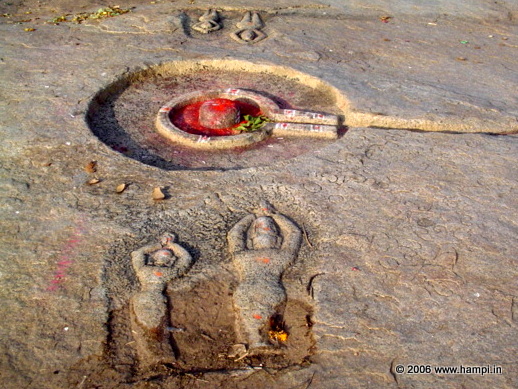
Linga with vermilion applied as mark of reverence. Also seen are images of people worshiping the Linga. Image from the Riverside Ruins site.
Linga with vermilion applied as mark of reverence. Also seen are images of people worshiping the Linga. Image from the Riverside Ruins site.
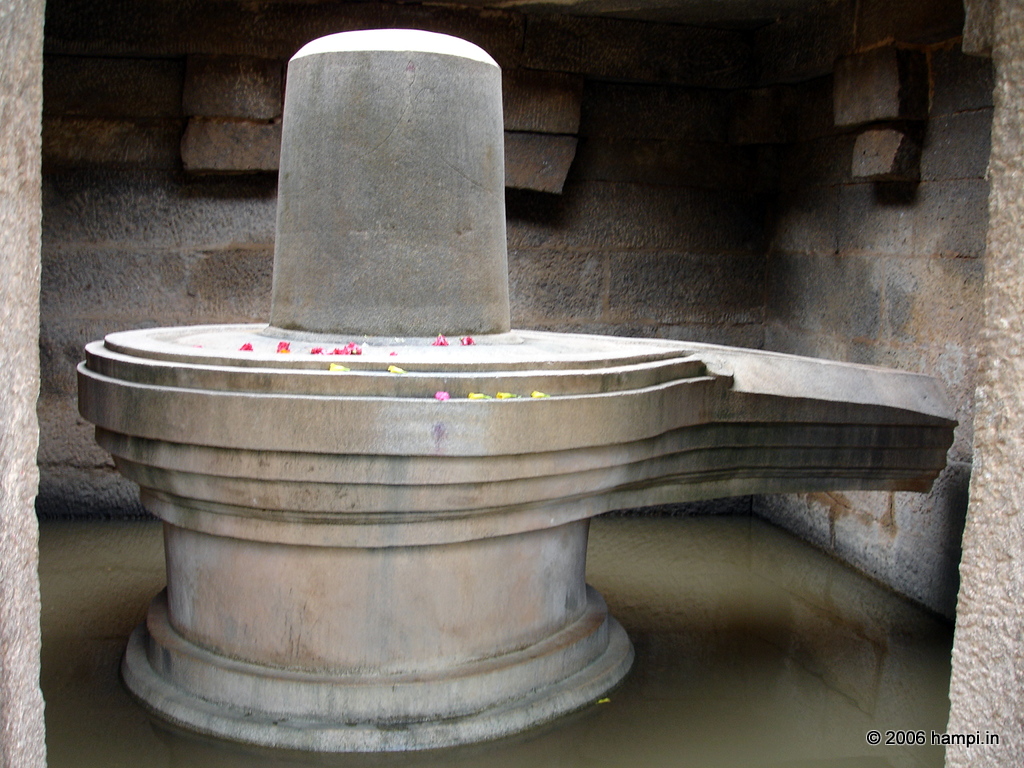
Badavilinga, the biggest linga in Hampi
Symbolically Siva is often represented with a phallic icon called Linga, positioned at the center of what represents as the female sexual organ. On a philosophical front this is explained as the balance of creative energies of the male and female. Or even the guiding code of the universe as a whole in some abstract way.
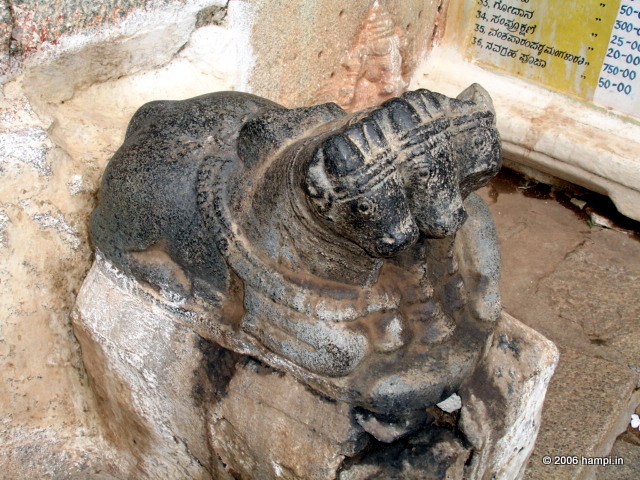
The triple headed Nandi inside Virupaksha Temple
The triple headed Nandi inside Virupaksha Temple
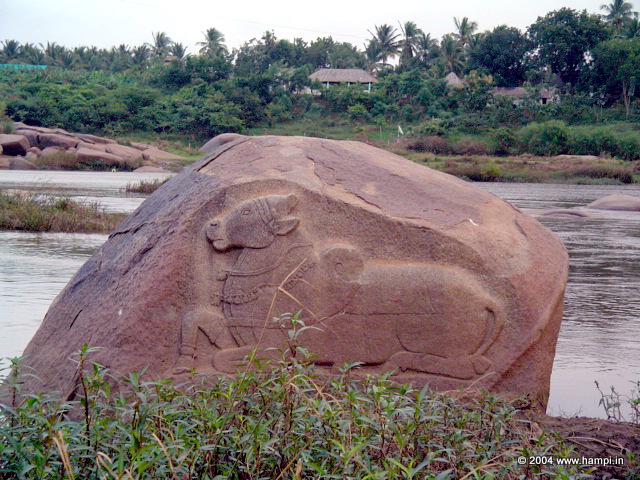
Nandi on Boulder
Nandi Image on the boulder in the river. The is located the bathing Ghat near Virupaksha Temple
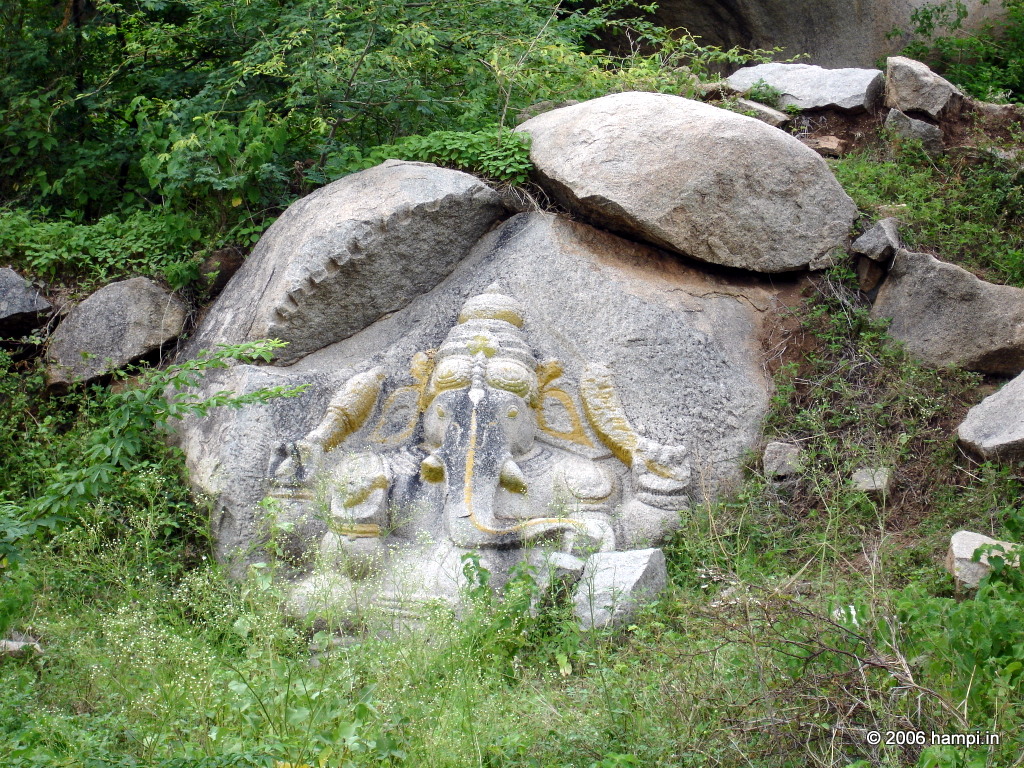
Bas-relief of Vinayaka (Ganapathi) image executed on a boulder.
Bas-relief of Vinayaka (Ganapathi) image executed on a boulder.

Vartious incarnations of Vishnu. On the right extreme is the image of Vittala aspect.
Vartious incarnations of Vishnu. On the right extreme is the image of Vittala aspect.

Hanuman as Anjaneya
Hanuman as Anjaneya, note the lotus bud at the tip of his tail
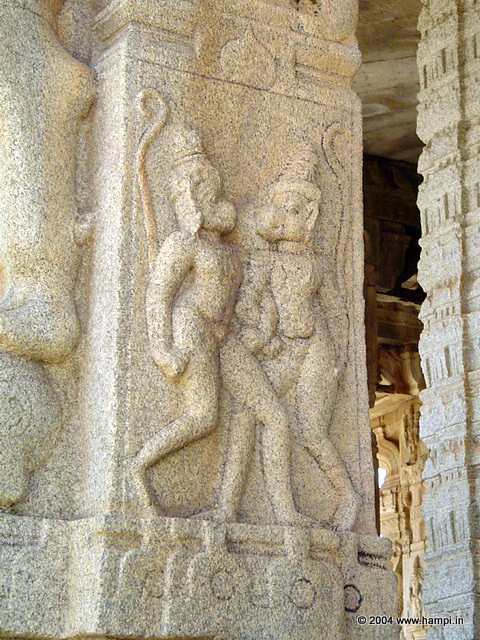
Vali and Sugreeva fighting
Vali and Sugreeva fighting. Image on the pillars of Vittala Temple
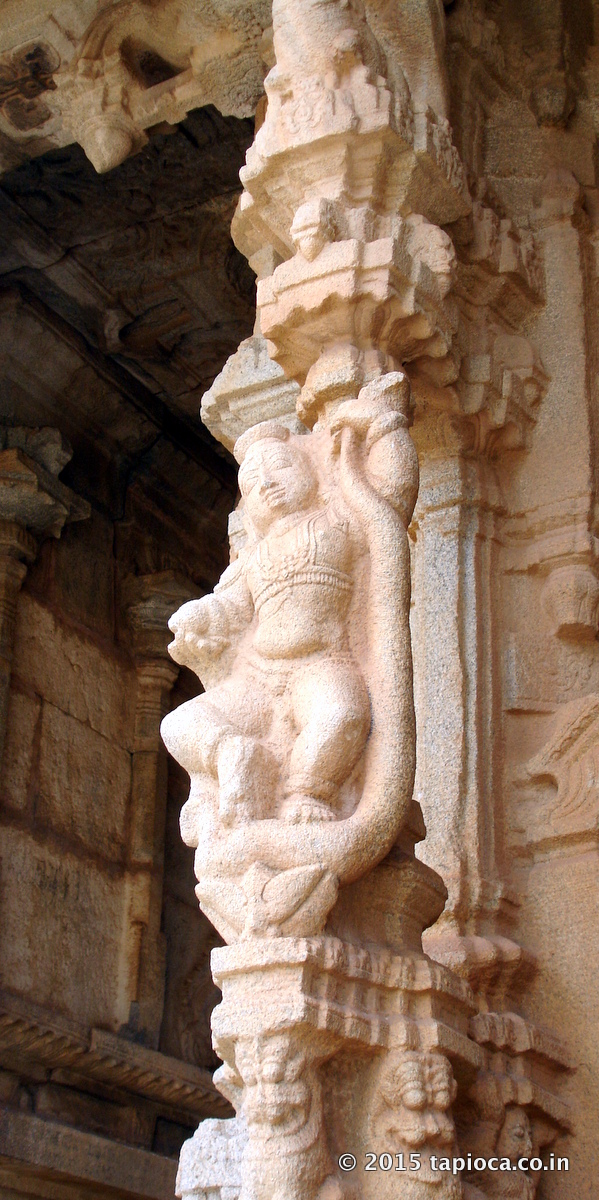
Krishna dancing on Kaliya. Pillar from Vittala Temple
Krishna dancing on Kaliya. Pillar from Vittala Temple
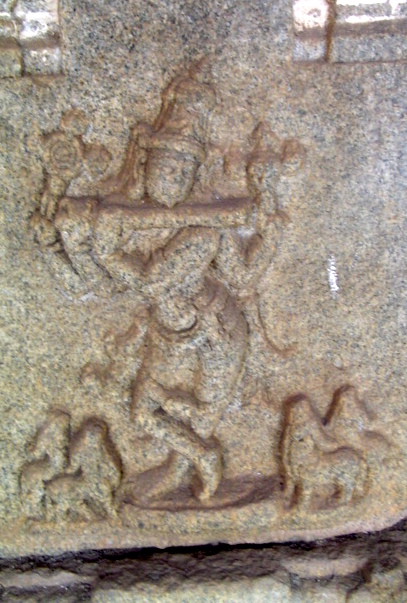
Krishna playing flute, the cows listening with rapt attention. Image from Achyuta Raya's Temple
Krishna playing flute, the cows listening with rapt attention. Image from Achyuta Raya's Temple
